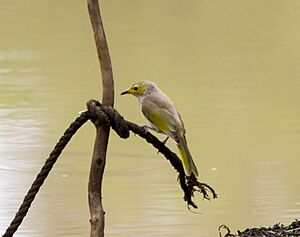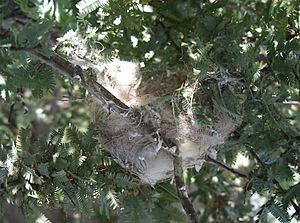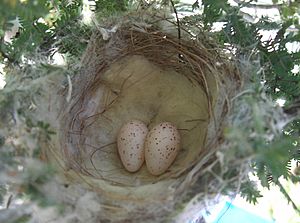White-plumed honeyeater facts for kids
Quick facts for kids White-plumed honeyeater |
|
|---|---|
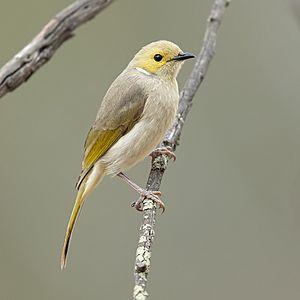 |
|
| At Glen Davis, New South Wales | |
| Conservation status | |
| Scientific classification | |
| Genus: |
Ptilotula
|
| Species: |
penicillata
|
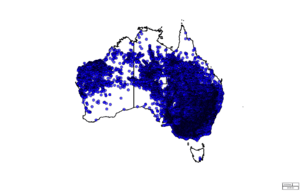 |
|
| Distribution | |
| Synonyms | |
|
Lichenostomus penicillatus |
|
The white-plumed honeyeater (Ptilotula penicillata) is a small bird that lives only in Australia. It is a type of passerine bird, also known as a perching bird. These birds are often found near water. You might even spot them in backyards and suburbs. They like places with lots of plants and trees.
Contents
About the White-plumed Honeyeater's Name
The white-plumed honeyeater was first described in 1837. An English scientist named John Gould gave it its first scientific name. He studied a bird from New South Wales, Australia. The name penicillata comes from a Latin word. It means 'brush tip'. This refers to the white feather patch on the side of its neck.
For many years, this bird was in the Meliphaga group. Later, in 1975, it moved to the Lichenostomus group. Scientists use special studies to understand bird families. These studies look at the birds' genes. In 2011, new studies showed the white-plumed honeyeater belonged in its own group. This group is called Ptilotula. The name Ptilotula comes from Ancient Greek words. They mean 'feather' and 'ear'.
Scientists think this bird might be very old. A fossil bone was found in Queensland. It looks very similar to a white-plumed honeyeater leg bone. This fossil is from a time called the Miocene epoch.
What Does the White-plumed Honeyeater Look Like?
Male and female white-plumed honeyeaters look very much alike. Their most special feature is a bright white feather patch. This patch goes from their throat to the back of their neck. The top of their head and neck are olive green. They have a yellow ring around their dark eyes. Their cheeks are yellow-olive. There is a short black stripe near the white neck patch. Their chin and throat are a dull yellowish-olive color.
The top part of their body is grey-olive. Their wing feathers are dark brown. They have yellowish edges. This makes a yellow-olive stripe when their wings are folded. Their tail is olive-brown. The underside of their body is light brown-grey. It has pale yellow streaks on the chest. Their belly is pale yellow and cream.
Their feet and legs are pinkish to purplish grey. During the time they lay eggs, their beak is black. At other times, the bottom part of their beak can be orange-yellow.
There are four slightly different types, or subspecies, of this bird. They are called P. p. penicillata, P. p. leilavalensis, P. p. carteri, and P. p. calconi. Some are paler or more yellow than others. These types can mix where their homes meet.
Males are a little bigger than females in all types. The P. p. penicillata is the largest. Males weigh about 20.5 g (0.72 oz). Females weigh about 18.1 g (0.64 oz). The smallest type is P. p. calconi. Males are around 17.5 g (0.62 oz). Females are about 16 g (0.56 oz).
Young white-plumed honeyeaters look like adults. But their head and neck colors are duller. Their eye-ring and ear feathers are brighter. The white neck patch is shorter and not as clear. Their beak is pink or yellowish at first. It changes to black as they grow. Their feet and legs look a bit swollen when they are very young.
Where Do White-plumed Honeyeaters Live?
These birds live across south-eastern Australia. You won't find them in Tasmania. They also live in parts of central and western Queensland. They are found in the Northern Territory and Western Australia too. They do not live in deserts. But they can survive in dry areas if there are trees and water.
The main type, P. p. penicillatus, lives in south-eastern Australia. This includes the Murray-Darling Basin. Other types live in different regions. For example, P. p. carteri lives in the Pilbara region of Western Australia.
These birds have spread to new areas over the last 100 years. They used to mostly live near river red gum trees. Now, they live in coastal cities like Sydney and Newcastle. They used to only visit these places sometimes. Studies show that these birds usually stay in one place. They rarely move more than 10 km (6.21 mi) from where they were born. They might move short distances if the weather changes.
They mostly live in open woodlands. These are often near water sources. This includes wetlands, swamps, and creeks. They love river red gum woodlands. They also live in areas with other types of gum trees.
What Do White-plumed Honeyeaters Eat?
The white-plumed honeyeater eats many different things. Their main foods are nectar from flowers and insects. They also eat sticky substances from plants like honeydew and lerp. Sometimes they eat fruit and seeds. They might peck at berries to drink the juice.
If there is enough water, they drink at least twice a day. In dry places, they get extra water from their food. One study found that they need to eat about 100 berries to get 1mL of water. They need 5-10mL of water each day. So, they can eat 500–1000 berries in five hours! This helps them get both food and water.
How They Find Food
White-plumed honeyeaters mostly find food by picking things off leaves. Their tongue is like a brush. It has about 60 tiny bristles. These bristles help them soak up nectar. They usually catch insects by picking them off plants. But they can also catch insects while flying.
In cities, they usually look for food high up in trees. But where they look can change. This depends on other birds living nearby. For example, if there are aggressive birds like fuscous honeyeaters, white-plumed honeyeaters will change how they feed. They might feed lower down in trees to avoid fights.
Scientists learn about their diet in different ways. They study bird droppings and what's in their stomachs. They also watch them eat. It was once thought that insects were a big part of their diet. But later research showed that insects are a smaller part. Insects give them protein and minerals. But nectar and other plant sugars give them most of their energy. They spend a lot of energy catching insects while flying. Sometimes it's more energy than the insect gives them back.
How White-plumed Honeyeaters Behave with Others
These birds like to be in groups. You can often see groups of 12 or more birds when they are not breeding. These larger groups break up when it's time to lay eggs. White-plumed honeyeaters often live in colonies. This means many nests are close together. Sometimes, birds might help each other raise young. But this is not very common. They might group together to chase away predators near nests. However, each bird still has its own small area within the colony. They sing more often during breeding season to protect their space.
Scientists have studied these birds in captivity. They found that birds form a pecking order. This order depends on their feather colors and how they sound. But we don't have much information about this in wild birds.
White-plumed honeyeaters can be aggressive. They fight with other birds of their own kind. They also fight with other species. This includes the yellow-faced honeyeater, willie wagtail, and red wattlebird. They also chase smaller birds like pardalotes and mistletoebirds. They usually try to avoid fuscous honeyeaters. In some areas, smaller birds are not found. This is because white-plumed honeyeaters and other similar-sized birds are very aggressive. They push out the smaller birds.
Groups of foraging birds might make a chip-chip call. Or they might sing a song that others nearby repeat. Sometimes, many birds (12 or more) will sit together on a branch. They make a lot of calls. Then they quickly fly away.
Reproduction and Life Cycle
Female white-plumed honeyeaters are most ready to breed from late winter to summer. But males can breed all year. They lay eggs throughout the year. They usually have 2–3 groups of eggs (clutches) per year. Breeding often happens when there are many plant-eating insects.
Their nests are small and shaped like a cup. They are about 5–6 cm (2.0–2.4 in) wide and deep. They build their nests very carefully. They use grasses and thin strips of bark. They hold it all together with spider webs. They line the inside with animal hair, wool, and feathers. The female bird usually builds the nest. But both parents help keep it in good shape. Nests are usually hidden in the leaves of trees or bushes. Sometimes they are in forks of branches.
Males perform a special song flight. They fly up and down above the treetops while singing. When the song ends, the male quickly dives into a nearby tree. They do this all day during breeding season. This display is likely to attract a mate. Other songs heard during breeding season might also be for courtship.
They usually lay 2–3 eggs. Sometimes it can be 1–4 eggs. The second egg is usually laid within 24 hours of the first. The eggs are about 20 mm × 15 mm (0.8 in × 0.6 in) in size. They weigh about 2.45 g (0.09 oz). They are oval-shaped and smooth. Their color can be white, pale yellow, or deep pink. They have tiny red spots near the larger end. Eggs laid later in the season tend to be lighter. Eggs from inland areas are usually white with fewer spots.
The female bird probably sits on the eggs alone. This takes 13–15 days. Both parents feed the baby birds in the nest. This lasts for 11–15 days. Then, they feed them for another 2 weeks after they leave the nest. After that, the young birds can take care of themselves. Some cuckoo birds lay their eggs in white-plumed honeyeater nests. These include the pallid cuckoo and fan-tailed cuckoo.
Conservation Status
The white-plumed honeyeater is considered a species of least concern for conservation. This means it is not currently at high risk of disappearing. This status is given by the International Union for the Conservation of Nature (IUCN).
Threats to White-plumed Honeyeaters
Animals like cats and dogs can be a danger to these birds. They are predators. Losing trees along rivers can also harm their populations. However, these birds can live well in suburban areas. Especially if there are native gardens with lots of plants.
How Climate Affects Them
Scientists have noticed that white-plumed honeyeaters have changed in size. They became smaller during long droughts. But overall, they have been getting larger since the 1960s. This change is linked to rising temperatures in the areas where they live. Their body size has increased by about 0.064% each year.
See also
 In Spanish: Mielero empenachado para niños
In Spanish: Mielero empenachado para niños



